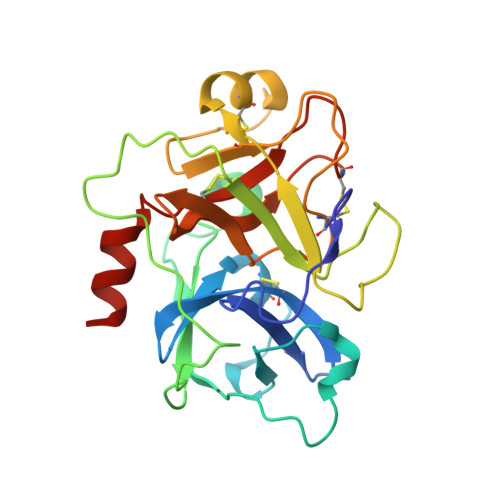Discovery of Potent and Orally Bioavailable Pyridine N-Oxide-Based Factor XIa Inhibitors through Exploiting Nonclassical Interactions.
Xu, G., Liu, Z., Wang, X., Lu, T., DesJarlais, R.L., Thieu, T., Zhang, J., Devine, Z.H., Du, F., Li, Q., Milligan, C.M., Shaffer, P., Cedervall, P.E., Spurlino, J.C., Stratton, C.F., Pietrak, B., Szewczuk, L.M., Wong, V., Steele, R.A., Bruinzeel, W., Chintala, M., Silva, J., Gaul, M.D., Macielag, M.J., Nargund, R.(2022) J Med Chem 65: 10419-10440
- PubMed: 35862732
- DOI: https://doi.org/10.1021/acs.jmedchem.2c00442
- Primary Citation of Related Structures:
7V0Z, 7V10, 7V11, 7V12, 7V13, 7V14, 7V15, 7V16, 7V17, 7V18 - PubMed Abstract:
Activated factor XI (FXIa) inhibitors are promising novel anticoagulants with low bleeding risk compared with current anticoagulants. The discovery of potent FXIa inhibitors with good oral bioavailability has been challenging. Herein, we describe our discovery effort, utilizing nonclassical interactions to improve potency, cellular permeability, and oral bioavailability by enhancing the binding while reducing polar atoms. Beginning with literature-inspired pyridine N-oxide-based FXIa inhibitor 1 , the imidazole linker was first replaced with a pyrazole moiety to establish a polar C-H···water hydrogen-bonding interaction. Then, structure-based drug design was employed to modify lead molecule 2d in the P1' and P2' regions, with substituents interacting with key residues through various nonclassical interactions. As a result, a potent FXIa inhibitor 3f ( K i = 0.17 nM) was discovered. This compound demonstrated oral bioavailability in preclinical species (rat 36.4%, dog 80.5%, and monkey 43.0%) and displayed a dose-dependent antithrombotic effect in a rabbit arteriovenous shunt model of thrombosis.
Organizational Affiliation:
Janssen Research & Development, L.L.C., 1400 McKean Road, Spring House, Pennsylvania 19477-0776, United States.




















